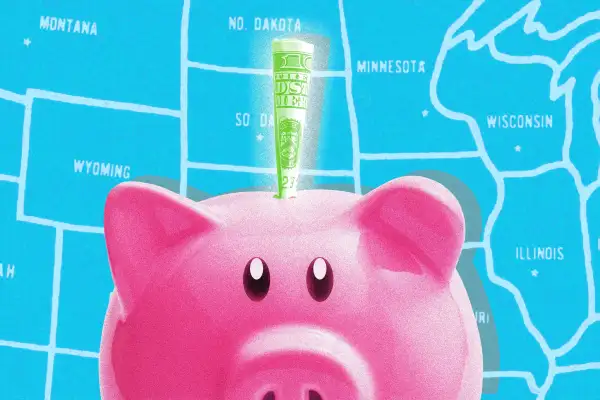5 Places Where the Minimum Wage Is Increasing on July 1

Some U.S. workers will soon earn more than double the federal minimum wage.
While the federal rate hasn't changed from $7.25 an hour since 2009, several states and cities are continuing to raise their wages in response to inflation and cost-of-living pressures — with some cities topping $19 an hour.
At the beginning of the year, 21 states and 48 cities raised their minimum wage rates. Now, another round of increases is set to take effect on July 1 in several places across the country.
Here's a breakdown of where wages are going up — and by how much.
Alaska
Alaska’s minimum wage will rise from $11.91 to $13 on July 1, the first in a series of scheduled hikes under Ballot Measure 1, which voters approved in the 2024 general election. The measure puts the state on track to reach a $15 minimum wage by 2027, with additional $1 increases set for July 1, 2026 and July 1, 2027.
In addition to raising the state’s minimum wage, the new law also requires employers to provide paid sick leave to employees working in Alaska (with certain exemptions) and bans mandatory workplace meetings where employers promote political or religious views.
Oregon
Oregon’s minimum wage will rise on July 1 as part of the state’s annual inflation-based adjustments. Since 2023, Oregon has tied its minimum wage increases to the Consumer Price Index (CPI), following a schedule originally established by Senate Bill 1532, which the Oregon state legislature passed in 2016.
The state uses a tiered minimum wage system with three regional rates: standard, Portland metro and non-urban. On July 1, the standard minimum wage will increase from $14.70 to $15.05 per hour. This rate applies to areas such as Benton, Clatsop, Columbia, Deschutes and others. Workers in the Portland metro area — including areas within the urban growth boundary — will see an increase of $15.95 to $16.30. Those in the non-urban boundary (including most rural counties) will see the hourly minimum wage increase from $13.70 to $14.05 per hour.
Washington, D.C.
Washington, D.C., has the highest minimum wage rate in the country — and it’s about to go even higher. In 2016, Mayor Muriel Bowser signed the Fair Shot Minimum Wage Amendment Act into law to raise D.C.’s minimum wage to $15 per hour by 2020. Since 2021, D.C. has continued increasing the rate annually, indexing it to inflation based on the CPI.
On July 1, the hourly minimum wage will rise from $17.50 to $17.95. The base wage for tipped workers will also increase — from $10 to $12 per hour. Employers must make up the difference if an employee's hourly tips (plus base wage) don’t average out to the full minimum wage weekly.
California
Earlier this year, California raised its statewide minimum wage from $16 to $16.50 per hour after California voters rejected Proposition 32 (a minimum wage measure on the November 2024 ballot that would have raised the state minimum to $18).
While the statewide minimum wage remains at $16.50, several California cities and counties will implement local minimum wage increases on July 1. These rates often exceed the state minimum due to cost-of-living differences. The upcoming rate increase includes the following:
- Alameda: $17 to $17.46
- Berkeley: $18.67 to $19.18
- Emeryville: $19.36 to $19.90
- Fremont: $17.30 to $17.75
- Los Angeles: $17.28 to $17.87
- Los Angeles County: $17.27 to $17.81
- Milpitas: $17.70 to $18.20
- Pasadena: $17.50 to $18.04
- San Francisco: $18.67 to $19.18
- Santa Monica: $17.27 to $17.81
California’s minimum wage has increased annually since 2017 under legislation signed by former Governor Jerry Brown. A 2024 provision allows wages of at least $15 to be raised annually — by up to 3.5% — if inflation exceeds 7% as measured by the CPI.
St. Paul, Minnesota
On July 1, small and micro businesses in St. Paul, Minnesota will raise their minimum wage rates as part of the city’s phased wage plan. Businesses with six to 100 employees will increase their rate to $15 per hour, while those with five or fewer employees will raise theirs to $13.25.
Earlier this year, large businesses (101-10,000 employees) and macro businesses (10,001-plus employees) increased their minimum wage rate from $15.47 to $15.97.
St.Paul’s tiered minimum wage system was established in 2018 under the Minimum Wage Ordinance signed by Mayor Melvin Carter. All employers must pay their employees at least $15 an hour by 2027.
More from Money:
Here's How Much Gas Prices Could Rise After U.S. Strikes in Iran
Top 10 U.S. Cities Where Home Sellers Are Offering Perks to Sweeten the Deal
The U.S. Dollar Is Weak. Here's How You Can Still Save on Summer Travel




